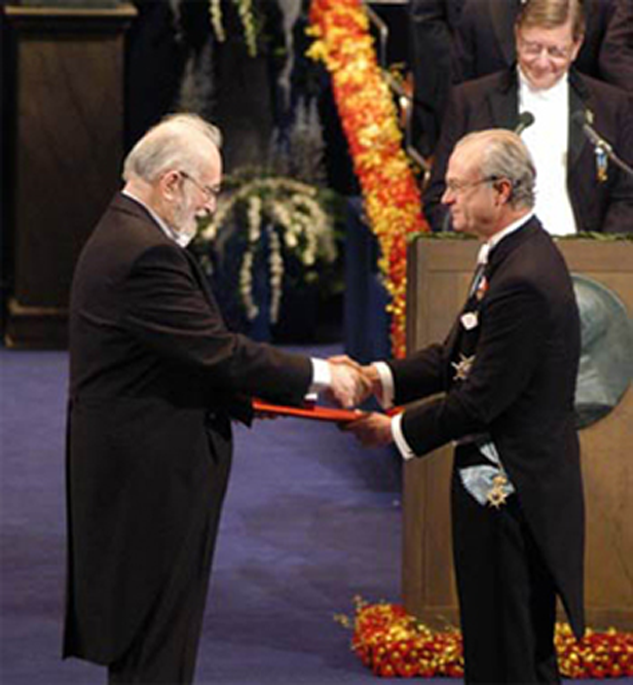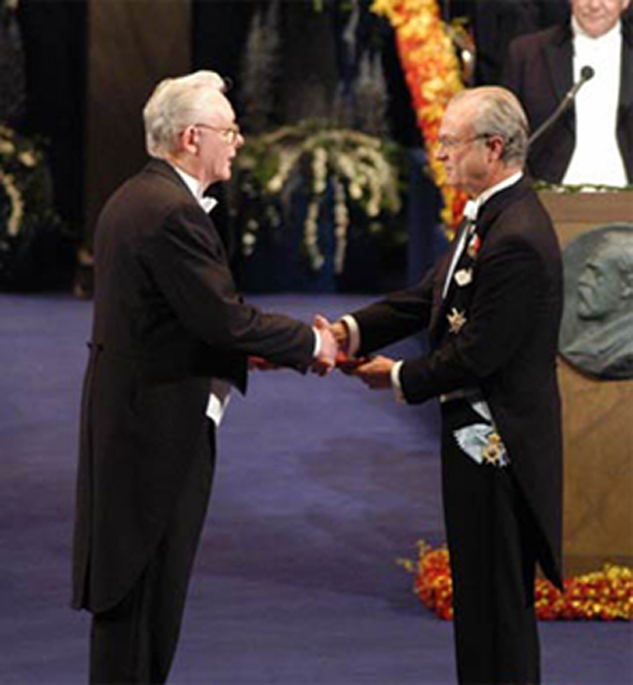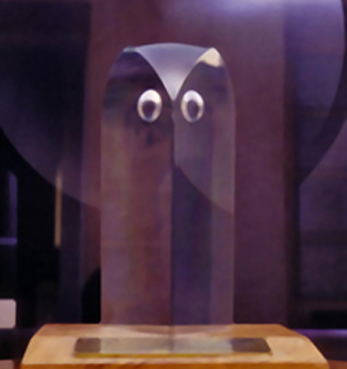





 Nobel Prizes
Nobel Prizes
A number of Nobel Prizes have been awarded for research results in NMR or neighboring disciplines. Among the recipients were:
 Otto Stern: Nobel Prize in Physics 1943
Otto Stern: Nobel Prize in Physics 1943
 Isidor I. Rabi: Nobel Prize in Physics 1944
Isidor I. Rabi: Nobel Prize in Physics 1944
 Felix Bloch and Edward M. Purcell: Nobel Prize in Physics 1952
Felix Bloch and Edward M. Purcell: Nobel Prize in Physics 1952
 Nicolaas Bloembergen: Nobel Prize in Physics 1981
Nicolaas Bloembergen: Nobel Prize in Physics 1981
 Richard R. Ernst: Nobel Prize in Chemistry 1991
Richard R. Ernst: Nobel Prize in Chemistry 1991
 Kurt Wüthrich: Nobel Prize in Chemistry 2002
Kurt Wüthrich: Nobel Prize in Chemistry 2002
Paul C. Lauterbur (Figure 20-62) received the Nobel Prize in Physiology or Medicine in 2003 for the invention of magnetic resonance imaging.
Peter Mansfield (Figure 20-63) shared this Nobel Prize for his further development of MRI.

Figure 20-62:
Paul C. Lauterbur receives the Nobel Prize from the King of Sweden.
The Nobel Foundation's announcement read:
"Paul Lauterbur discovered the possibility to create a two-dimensional picture by introducing gradients in the magnetic field. By analysis of the characteristics of the emitted radio waves, he could determine their origin. This made it possible to build up two-dimensional pictures of structures that could not be visualized with other methods.”

Figure 20-63:
Peter Mansfield receives the Nobel Prize from the King of Sweden.
The announcement for Peter Mansfield read:
"Peter Mansfield further developed the utilization of gradients in the magnetic field. He showed how the signals could be mathematically analysed, which made it possible to develop a useful imaging technique. He also showed how extremely fast imaging could be achievable. This became technically possible within medicine a decade later."
 This was the first Nobel Prize in Physiology or Medicine awarded in the field.
This was the first Nobel Prize in Physiology or Medicine awarded in the field.
Paul C. Lauterbur commented on this in a lecture given in Lund, Sweden, some days after the Prize Ceremony in Stockholm:
"It has been noted that the Nobel Prize for the development of MRI was awarded to a chemist and a physicist. That is not accidental. The field developed from a discipline that was first the province of physicists, two of whom share a Nobel Prize for it, and then became most prominent in its applications to chemistry, so that chemists received the next two Nobel Prizes, for novel techniques and applications. Although the needs of medical diagnosis stimulated the development of MRI, it was firmly grounded in the knowledge and instruments of physicists and chemists, as well as of those of mathematicians and engineers, all far from the knowledge and concerns of physicians, who became its greatest beneficiaries."
 European Magnetic Resonance Award
European Magnetic Resonance Award
Since 1986, the European Magnetic Resonance Forum (EMRF) and The Round Table Foundation (TRTF) confered the European Magnetic Resonance Award upon those scientists without whom magnetic resonance imaging as a patient-friendly non-invasive diagnostic technology in medicine would not exist. Since 1991 two Awards are granted, one for advances in medical applications and one for research in basic sciences; in a number of years, the Awards were combined. Since 1994, the Award is biennial. After 2012, the Award is only given at special occasions (see also: Pro Academia Prize).

Figure 20-64:
The Award is a crystal owl, representing Athena, the goddess of crafts and skilled peacetime pursuits. She personifies wisdom and righteousness. Thus, the Award symbolizes scientific perseverance and knowledge turned into cutting edge results with a direct impact on patient care.
Recipients of the European Magnetic Resonance Award
 Paul C. Lauterbur, Urbana-Champaign (1986)
Paul C. Lauterbur, Urbana-Champaign (1986)
 John Mallard, Aberdeen (1987)
John Mallard, Aberdeen (1987)
 Peter Mansfield, Nottingham (1988)
Peter Mansfield, Nottingham (1988)
 Graeme M. Bydder, London (1989)
Graeme M. Bydder, London (1989)
 Axel Haase, Würzburg, and Jens Frahm, Göttingen (shared award, 1990)
Axel Haase, Würzburg, and Jens Frahm, Göttingen (shared award, 1990)
 Werner Kaiser, Bonn, and Ian Young, London (1991)
Werner Kaiser, Bonn, and Ian Young, London (1991)
 Roberto Passariello, Rome, and Jürgen Hennig, Freiburg (1992)
Roberto Passariello, Rome, and Jürgen Hennig, Freiburg (1992)
 Donald Longmore, London, and Raimo Sepponen, Helsinki (1993)
Donald Longmore, London, and Raimo Sepponen, Helsinki (1993)
 Anders Hemmingsson, Uppsala, and Denis Le Bihan, Paris (1994)
Anders Hemmingsson, Uppsala, and Denis Le Bihan, Paris (1994)
 Thomas Vogl, Berlin, and Hanns-Joachim Weinmann, Berlin (1996)
Thomas Vogl, Berlin, and Hanns-Joachim Weinmann, Berlin (1996)
 Gustav K. von Schulthess, Zurich, and Patrick J. Cozzone, Marseille (1998)
Gustav K. von Schulthess, Zurich, and Patrick J. Cozzone, Marseille (1998)
 Robert N. Muller, Mons (Special Award 1998)
Robert N. Muller, Mons (Special Award 1998)
 Peter A. Rinck, Sophia Antipolis (Special Award 1998)
Peter A. Rinck, Sophia Antipolis (Special Award 1998)
 Guy Marchal, Leuven, and Chrit T. Moonen, Bordeaux (2000)
Guy Marchal, Leuven, and Chrit T. Moonen, Bordeaux (2000)
 Gerhard Laub, Erlangen, and Peter Luijten, Utrecht (2002)
Gerhard Laub, Erlangen, and Peter Luijten, Utrecht (2002)
 Klaas P. Pruessmann, Zurich, and Silvio Aime, Turin (2004)
Klaas P. Pruessmann, Zurich, and Silvio Aime, Turin (2004)
 Christiane Kuhl, Bonn, and Jacques Bittoun, Paris, France (2006)
Christiane Kuhl, Bonn, and Jacques Bittoun, Paris, France (2006)
 Klaes Golman, Malmö, and Luis Martí-Bonmatí, Valencia (2008)
Klaes Golman, Malmö, and Luis Martí-Bonmatí, Valencia (2008)
 John Griffiths, Cambridge, and Stefan Neubauer, Oxford (2010)
John Griffiths, Cambridge, and Stefan Neubauer, Oxford (2010)
 Erik Odeblad, Umeå (2012)
Erik Odeblad, Umeå (2012)
 In addition, there are numerous research prizes given by societies in the field of magnetic resonance imaging.
In addition, there are numerous research prizes given by societies in the field of magnetic resonance imaging.